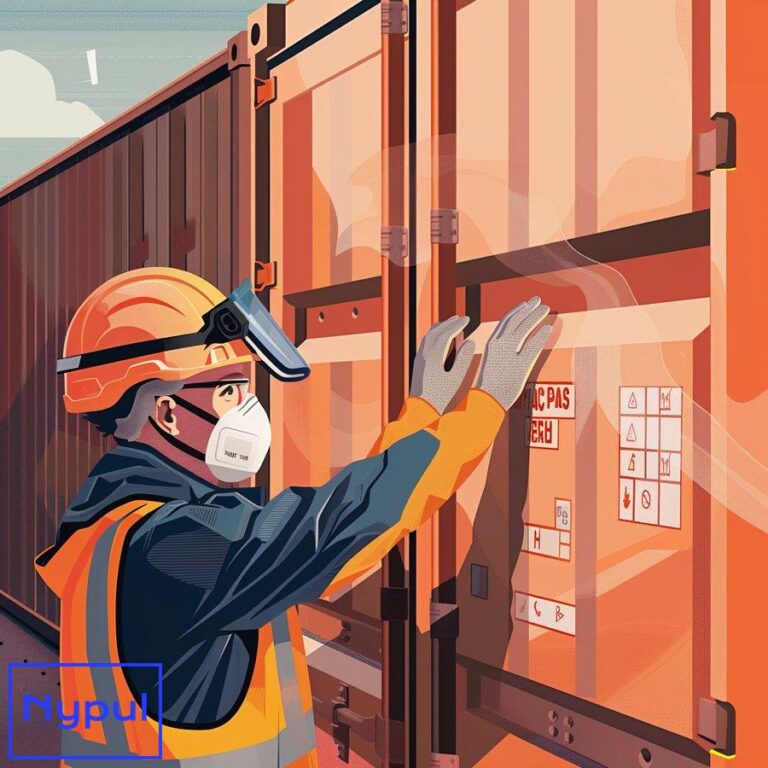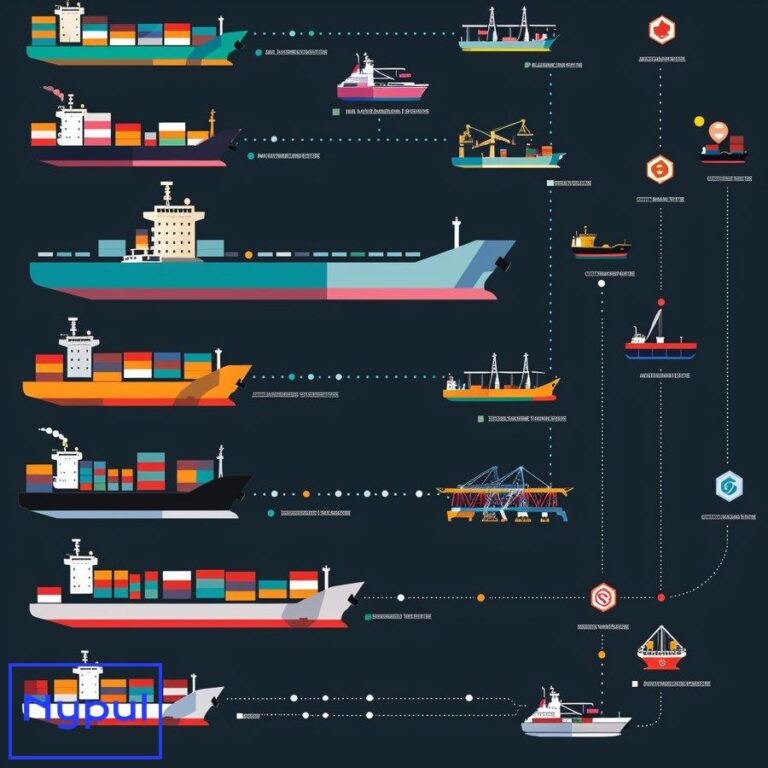What Happens if a Container Is Overweight
What constitutes an overweight container?
A shipping container is considered overweight when its gross weight, including the container itself, the cargo, and any dunnage or securing materials, exceeds the maximum allowable weight limits for transportation by road or rail. These limits vary depending on the container size, chassis type, and the specific regulations of the country, state, or jurisdiction through which the container is being transported.
In the United States, the most common weight limits are:

- 20′ container on a standard chassis: 40,000 lbs (18,144 kg)
- 20′ container on a tri-axle chassis: 44,000 lbs (19,958 kg)
- 40′ container on a standard chassis: 45,000 lbs (20,412 kg)
- 40′ container on a tri-axle chassis: 47,000 lbs (21,318 kg)
However, these limits can vary significantly between states and even between different roads within a state. For example, some states allow higher weights on designated overweight corridors near ports, while others have stricter limits on certain highways or bridges.
It’s important to note that the weight limits apply to the entire vehicle, including the tractor, chassis, container, and cargo. So a container that is within the weight limit for ocean transport may still be considered overweight for domestic transportation if the total vehicle weight exceeds the legal limit.
What are the common causes of overweight containers?
There are several common reasons why a container may become overweight:
-
Incorrect weight declaration: Shippers may underestimate or misrepresent the weight of the cargo, either intentionally to save on freight costs or unintentionally due to inaccurate weighing methods.
-
Improper loading: Unevenly distributing the cargo within the container can cause certain areas to exceed the weight limit, even if the total weight is within the allowable range.
-
Heavier cargo: Some commodities, such as construction materials, machinery, or dense liquids, simply weigh more than others, making it challenging to stay within the weight limits.
-
Packaging and dunnage: The weight of pallets, crates, and other packaging materials, as well as any blocking, bracing, or dunnage used to secure the cargo, can add significant weight to the container.
-
Tare weight: The weight of the empty container itself, known as the tare weight, can vary depending on the manufacturer and the materials used in its construction. Heavier containers can push the total weight over the limit.
-
Moisture and condensation: Water absorbed by hygroscopic cargo or condensation buildup in the container can add unexpected weight.
-
Inaccurate weighing equipment: Scales used to weigh the cargo may not be properly calibrated or may have other issues that result in inaccurate measurements.
To avoid overweight containers, shippers should carefully calculate the total weight, including all components, and ensure that the cargo is evenly distributed within the container. Using accurate weighing equipment and declaring the correct weight on shipping documents is also crucial.
What safety hazards are associated with overweight containers?
Overweight containers pose several safety risks, both during transportation and when being handled at ports or warehouses:
-
Increased risk of accidents: Overweight vehicles are more difficult to control, especially when braking or maneuvering, increasing the likelihood of collisions with other vehicles or objects.
-
Damage to infrastructure: Roads, bridges, and other transportation infrastructure are designed to support specific weight limits. Exceeding these limits can cause accelerated wear and tear, potentially leading to structural damage or collapse.
-
Chassis and container damage: The weight of the cargo can put excessive stress on the chassis, container, and securing equipment, leading to cracks, deformation, or even failure.
-
Cargo damage: Improperly distributed weight or excessive forces can cause damage to the cargo itself, leading to financial losses and potential liability issues for the shipper.
-
Injuries to workers: When overweight containers are being handled at ports or warehouses, the increased weight and potential for instability can put workers at risk of injury from falling cargo or crushing incidents.
-
Environmental hazards: In the event of an accident involving an overweight container, the potential for spills or leaks of hazardous materials is increased, posing a risk to the environment and public health.
To mitigate these safety risks, it is crucial for shippers, carriers, and transportation providers to adhere to weight limits and ensure that containers are properly loaded and secured. Regular maintenance and inspection of equipment, as well as proper training for workers handling overweight containers, can also help reduce the risks.
How do overweight containers affect vessel stability?
Overweight containers can have a significant impact on the stability and safety of the vessels that transport them. When a container is heavier than its declared weight, it can throw off the carefully calculated stowage plan developed by the vessel’s captain and crew.
The main ways overweight containers affect vessel stability are:

-
Incorrect weight distribution: If heavier containers are stowed on top of lighter ones, it can create an unstable stack that is more prone to collapse or shifting during the voyage.
-
Exceeding weight limits: Most vessels have strict limits on the total weight that can be loaded, as well as the weight that can be stacked on each individual cell or deck. Overweight containers can cause these limits to be exceeded, compromising the vessel’s stability.
-
Reduced stability margins: Vessels are designed with a certain amount of stability built in, but overweight containers can reduce these margins, making the ship more vulnerable to capsizing in heavy seas or high winds.
-
Increased stress on the hull: The weight of the containers, especially when unevenly distributed, puts additional stress on the vessel’s hull, which can lead to structural damage over time.
-
Increased risk of container loss: Overweight and unstable stacks are more likely to collapse or be lost overboard during heavy weather, potentially damaging the vessel and polluting the environment.
To maintain vessel stability, it is critical that shippers accurately declare the weight of their containers and that carriers carefully plan the stowage to ensure that weight is evenly distributed. Regular monitoring of the vessel’s stability during the voyage is also necessary to make adjustments as needed.
What regulations govern overweight containers?
There are several key regulations that govern the weight of shipping containers, both internationally and within specific countries and regions:
-
SOLAS Convention: The International Maritime Organization’s Safety of Life at Sea (SOLAS) Convention requires shippers to provide a verified gross mass (VGM) for each packed container before it can be loaded onto a vessel. This helps ensure that vessels are loaded safely and that weight is accurately declared.
-
U.S. Federal Bridge Formula: In the United States, the Federal Bridge Formula is used to calculate the maximum weight allowed on a vehicle based on the number and spacing of its axles. This formula is used to determine if a container is overweight for domestic transportation.
-
U.S. Federal Motor Carrier Safety Regulations: These regulations set maximum weight limits for commercial motor vehicles, including those transporting shipping containers. Carriers must comply with these limits to avoid fines and penalties.
-
State and local regulations: Individual U.S. states and local jurisdictions may have their own regulations governing the weight of containers and vehicles. These can vary significantly, with some states allowing higher weights on designated routes or with special permits.
-
International standards: The International Organization for Standardization (ISO) has developed standards for the construction and testing of shipping containers, including weight limits. These standards help ensure that containers can safely transport cargo without exceeding weight limits.
Compliance with these regulations is essential to ensure the safety of workers, the public, and the environment. Shippers, carriers, and transportation providers must work together to accurately declare container weights and comply with all applicable regulations.
What penalties do shippers face for overweight containers?
Shippers who transport overweight containers can face a range of penalties, depending on the severity of the violation and the specific regulations in the jurisdiction where the violation occurs. Some common penalties include:
-
Fines: Shippers may be subject to hefty fines, often based on a per-pound or per-kilogram rate for the amount the container exceeds the weight limit. These fines can quickly add up to thousands or even millions of dollars.
-
Cargo seizure: In some cases, authorities may seize the cargo or the entire container if it is found to be significantly overweight. This can lead to delays, additional fees, and potential loss of the cargo.
-
Liability for damages: If an overweight container causes damage to roads, bridges, or other infrastructure, the shipper may be held liable for the repair costs. They may also face liability if the overweight container causes an accident that results in injuries or property damage.
-
Suspension or revocation of operating licenses: Repeated violations or particularly egregious cases of overweight containers may result in the suspension or revocation of the shipper’s operating licenses or permits, effectively shutting down their business.
-
Criminal charges: In some cases, shippers who knowingly and repeatedly transport overweight containers may face criminal charges, such as reckless endangerment or fraud, if they have intentionally misrepresented the weight of the cargo.
To avoid these penalties, shippers must carefully calculate the weight of their containers, ensure that the cargo is evenly distributed, and accurately declare the weight on all shipping documents. Regular monitoring and adjustments to the cargo may be necessary to maintain compliance with weight limits throughout the transportation process.
How can shippers accurately declare container weights?
Accurately declaring the weight of a shipping container is essential to ensure compliance with regulations and maintain the safety of transportation infrastructure and personnel. Here are some key steps shippers can take to accurately declare container weights:
-
Use certified weighing equipment: Shippers should use calibrated, certified scales to weigh the cargo and the empty container. This ensures that the measurements are accurate and can be relied upon for the verified gross mass (VGM) declaration.

-
Weigh all components: When calculating the total weight of the container, shippers should include the weight of the cargo, the container itself, any pallets or dunnage used for securing the cargo, and any other materials that will be loaded into the container.
-
Distribute weight evenly: Shippers should ensure that the cargo is evenly distributed within the container to avoid creating areas of concentrated weight that could exceed axle or other weight limits.
-
Document the process: Shippers should keep detailed records of the weighing process, including the date, time, location, and the specific equipment used. This documentation can be used to verify the accuracy of the weight declaration if needed.
-
Use the correct units: Shippers should use the appropriate units of measurement (pounds or kilograms) and ensure that the weight is accurately converted between units if necessary.
-
Communicate with carriers: Shippers should clearly communicate the verified gross mass to the carrier and any other relevant parties, such as terminal operators, to ensure that the container is handled and transported safely.
By following these best practices, shippers can help ensure that container weights are accurately declared and that transportation is conducted safely and efficiently.
What are overweight corridors and how do they work?
Overweight corridors are designated routes near ports or other transportation hubs where containers that exceed standard weight limits can be transported with special permits. These corridors are designed to facilitate the movement of heavy cargo while minimizing the impact on local roads and infrastructure.

Here’s how overweight corridors typically work:
-
Designated routes: Overweight corridors are clearly marked and mapped out, often with signs indicating the weight limits and permit requirements.
-
Special permits: Carriers transporting containers through an overweight corridor must obtain special permits from the relevant local or state authorities. These permits specify the weight limits, routing, and any other conditions that must be met.
-
Specialized equipment: Carriers transporting overweight containers often use specialized equipment, such as tri-axle chassis or multi-axle tractors, to distribute the weight more evenly and comply with axle weight limits.
-
Transloading: In some cases, containers that are overweight for domestic transportation may be transloaded onto multiple trucks or onto a rail car for the long-haul portion of the journey. This allows the cargo to be transported legally while still taking advantage of the overweight corridor for the short drayage move.
-
Enforcement: Overweight corridors are typically patrolled by law enforcement or transportation authorities to ensure that carriers are complying with the permit requirements and weight limits.
Overweight corridors can provide significant benefits to shippers and carriers by reducing transportation costs and delays associated with overweight containers. However, they also require careful planning and coordination to ensure that all applicable regulations are met and that the safety of transportation infrastructure and personnel is maintained.
How can special permits help with overweight container transport?
Special permits can play a crucial role in facilitating the transportation of overweight containers while ensuring compliance with regulations and maintaining the safety of transportation infrastructure and personnel. Here are some key ways that special permits can help:
-
Increased weight limits: Special permits often allow for higher weight limits than standard regulations, enabling shippers to transport heavier cargo without incurring additional costs or delays.
-
Designated routes: Special permits may specify certain routes or corridors that are approved for overweight transportation, such as the overweight corridors mentioned earlier. This helps to minimize the impact on local roads and infrastructure.
-
Specialized equipment: Special permits may require the use of specialized equipment, such as tri-axle chassis or multi-axle tractors, to distribute the weight more evenly and comply with axle weight limits.
-
Transloading: In some cases, special permits may allow for the transloading of cargo from overweight containers onto multiple trucks or rail cars for the long-haul portion of the journey. This enables shippers to take advantage of the higher weight limits while still complying with regulations.
-
Coordination with authorities: Special permits require close coordination with local and state authorities to ensure that all applicable regulations are met and that the necessary approvals are obtained.
-
Reduced fines and penalties: By obtaining the necessary special permits and complying with their requirements, shippers can reduce the risk of fines and penalties associated with overweight containers.
However, it’s important to note that special permits are not a one-size-fits-all solution. The specific requirements and weight limits can vary significantly between different jurisdictions and authorities. Shippers and carriers must carefully research the applicable regulations and obtain the necessary permits well in advance of the planned transportation.




